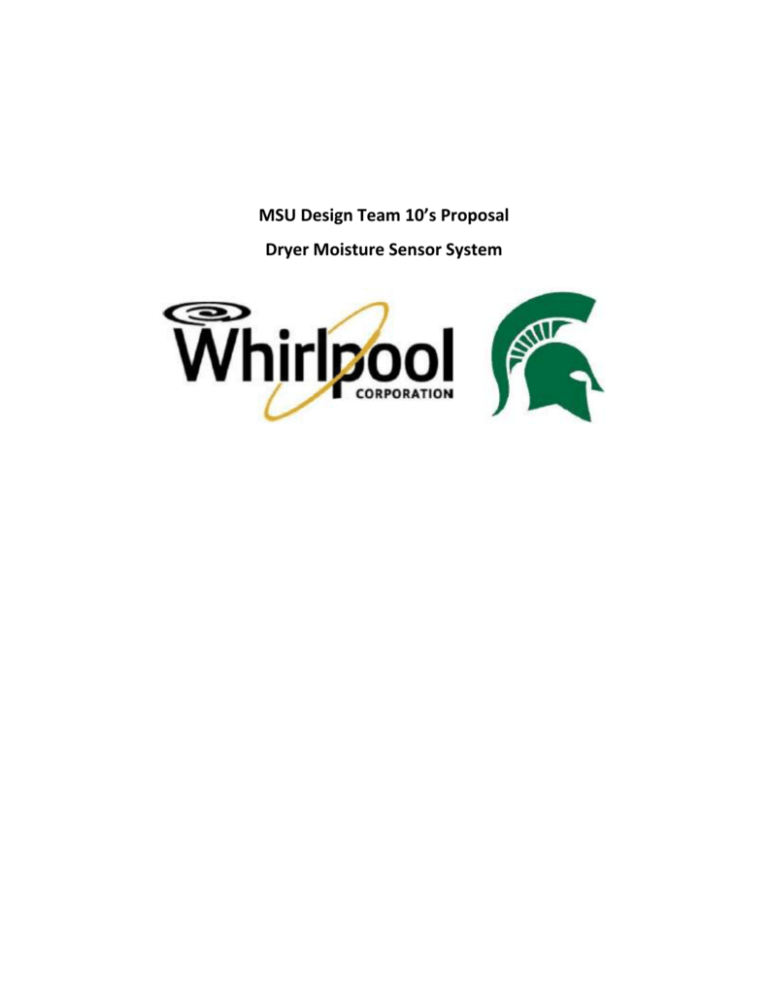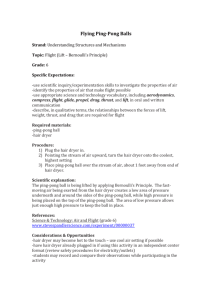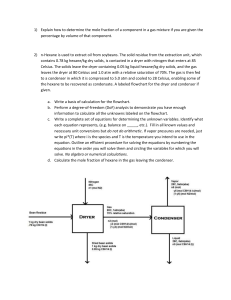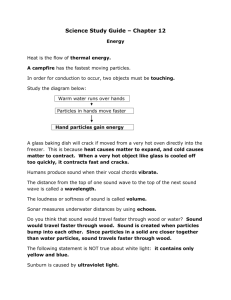Proposal
advertisement

MSU Design Team 10’s Proposal Dryer Moisture Sensor System Introduction: MSU Design Team 10 consists of 1. Thurakij Praditukrit Computer Engineering, Management 2. Qi Luo Electrical Engineering, Webmaster 3. James Fashoda Computer Engineering, Document Prep. 4. William Wang Electrical Engineering, Presentation Prep. 5. Ariadna Fernandez Electrical Engineering, Lab Coordinator Our sponsor is Whirlpool Corporation who is one of the leading companies in home appliances and our facilitator who monitors the progression on our design project is Dr. Ramakrishna Mukkamala. Whirlpool Corporation is also supporting the team with engineers: Josh Fisher, Mike Range and Cory Graves. ECE 480 Team 10 has been tasked to find a solution in order to make temperature and moisture sensors inside the dryer to communicate via wireless. The team is a very diverse group and we are excited towards working on the project together. The group is composed by two computer engineers and three electrical engineers which balances the team as an all-round team performance. Background: A dryer is a device or machine that dries objects, typically clothes. The concept behind these devices (dryers) is evaporation. This phenomenon is part of the water cycle. It is a process where water changes from liquid to gas or vapor. In order to evaporation to occur, it is necessary to transform energy into heat. When the water reaches a temperature of 212°F or 100°C, the molecules will break and the evaporation process will start. Once these molecules are in the air, they are sucked into a vacuum inside of the drum and pushed out through the exhaust pipe. Although there might be other methods that could be used to eliminate the amount of water on the object that is desired to dry, evaporation is the faster and easier way to eliminate the residual water. There are also some other features that companies will take in count at the moment of designing a dryer. These features includes air movements, high temperature, and energy efficient and low humidity. A dryer’s internal consists of many parts, see figure 1. The most important parts that relate to this project are a drum, baffles, and an ACU. A drum is the biggest part in the dryer where the clothes are located. There is also the baffles, these are located inside the drum. When the drum spins to dry clothes, the role of baffles are to change the motion of the clothes so that they are evenly dried. As any other electrical and automatized device, the ACU or Appliance Control Unit is a master processor which it controls the functionality of the dryer. Figure 1. Schematic of a Functional dryer. Description of the problem and design specifications: The project is Dryer Moisture System sponsored by Whirlpool. The sponsor specifications are described in the following statements: “Deliver an electronic system that is capable of sensing garment dryness attributes (temperature, moisture, humidity, etc.) from within the dryer’s rotating baffle and communicating this information to the “appliance control unit” (ACU) without the use of physical wires. The cost of the total system solution should not exceed $5.00. This includes the cost of the ACU circuit, sensing circuit, and the interface between them. System solution should last life of product. Average life of dryer is 10 to 12 years, but 20 and 30 year old dryers are common” The wireless requirement is an important specification in this project. The current technology uses temperature sensors located in the heating vent of the dryer along with moisture strips located in the back and front of the dryer. The problem with this situation is that the load will not always be touching the clothes and the temperature sensors monitor only the temperature of the air instead of the clothes themselves. By implementing a wireless technology inside the baffles, it would be possible to get a more accurate reading of the temperature of the clothes by increasing the amount of contact between laundry clothes and the sensors since the baffles (Figure 2) touch the clothes the most. By doing this, the dryer would stop the operation when the load is dry and not just by a specific amount of time. This project could be a perfect solution to make dryers more energy efficient. If the dryer is able to stop because the clothes are dry without a specific of time, it will avoid unnecessary running time and be more eco-friendly. Another reason why such improve in the performances of the dryers are necessary is that it can prevent the damage that could be done to clothes from the heat it produces. The less time the clothes are exposed to heat, the less the damage to the fabric. Figure 2. Drum’s Internal with Four Baffles Proposed design solution: The group has panned out different options for wireless technologies that could work with by listing the important attributes necessary to account for considerations. As shown in Figure 3, the Radio Frequency technology is rated as the best option decided among the group and Whirlpool team because of the simplicity this technology brings, and it is also widely available comparing to other technologies in the table. The distance is not seen as a problem because all the components are close to each other regardless. Another reason that the Radio Frequency is chosen is because the group is more familiar and comfortable with this technology. Potential Concepts (Rank 1 - 5) Attributes Importance (Rank 1 - 5) Wi-Fi Bluetooth Optical ZigBee Radio Power Consumption 4 3 3 5 4 5 Data packets 2 4 3 5 3 4 Range/distance 3 3 3 5 3 4 Frequency 2 4 5 5 5 4 Cost 5 3 1 3 4 4 Durability 5 4 3 4 5 3 Size 2 2 4 3 3 4 Simplicity 4 2 4 4 3 4 Availability 5 3 3 3 4 5 SCORE 97 96 127 124 132 Figure 3. Pugh Matrix - Wireless technology rating table One of the key goals of this project is to have a fully functional sensor system that transfers data wirelessly. However there are many different types of wireless systems that can be implemented on the design, each with their own advantages and disadvantages. A Pugh Matrix as demonstrated above helps scores each wireless capability based a various set of attributes. The attributes are then ranked based on how important they are to the design project. Thus once the matrix is filled out, each type of wireless capability will output a certain score. Although it is by no means to base a final decision on, the matrix allows a clear visualization into which wireless methods would be the best to implement with the design and acts as a great foundation for where to start off in the research. Based on the scores of the matrix, the top 3 candidates for wireless were optical, zigbee or radio. Through further research the team found that zigbee would be too complicated to implement, optical requires too much maintenance and micromanagement. Thus the team came to a conclusion that radio was the best option for the project because of simplicity, and readily available parts at low cost. Figure 4. Fast Diagram The group did some research on the current technology in dryers today and one proposed solution is that it will be good idea to increase the amount of sensors in the dryer and located them in different places throughout the drum. The places that we have discussed that seem to be most reasonable are inside the baffles since the baffles are detachable because we do not want to punch through the metal drum. We also want to attach the sensors close to the inside surface of the baffles for when the baffles have higher temperature, the sensors catch the same temperature as well. Once the sensors catch the temperature, we turn them into data and send back to our receiver outside the drum. We plan on making data transferring wireless since doing it wired is out of the question due to the spinning drum that would eventually tear the wires apart. The components associated with the design that we will be using are: ● ● ● STM32F105RBt6 Microcontrollers MX-05 Transmitter modules MX-FS-03V Receiver modules ● LM35DZ Temperature Sensors ● Raspberry Pi 2 Model B ● Inductive Charging sets ● Quarter Wavelength Antenna ● The STM32F105RBt6 Microcontrollers will be connected to the MX05 Transmitter module and both attached inside a baffle as well as the LM35DZ temperature sensor and Inductive Charging sets because we want them to be able to be self-powered since we are making this design wireless. The MX-FS-03V Receiver module will be outside the drum connecting with Raspberry Pi 2 Model B as well as connecting with the Quarter Wavelength Antennas. Resources and Availability: The group has enough resources in the lab to work on the design. The sponsor also sent us the dryer to test it with the design. The problem that the group is concerned as far is the power outlets in the lab does not provide the correct power needed to run the dryer at full functionality which is heat production. The dryer requires 240V to perform at its best but the ability in the lab is only 120V outlet so far which means that the group will have to push the temperature sensor testing towards the end of our testing phases until we could get more availability on it. If the proposed design is not fully functional, the group has other possible solutions as it was presented in the Pugh matrix. See figure 3. Schedule for Design Project: Week 1 Project Preference Rankings. Teams not formed. Week 2 First meeting with team. Contact sponsor and facilitator. Week 3 Meet with sponsor and facilitator. Week 4 Brief layout of the design. Discuss and pick component parts for design. Week 5 Examine dryer. Look at spaces we can work on putting our components. Week 6 Order components. Week 7 Testing phase. Make our wireless components communicate to each other. Week 8 Same as Week 7 Week 9 Design baffles as needed with the attached sensors. Week 10 Look at self-powered components for transmitters/receivers in the baffles Week 11 Put everything together, test, and troubleshoot. Week 12 Same as Week 11 Week 13 Demo Project Prototype Week 14 Professional self-assessment paper Week 15 Final Report and Design Day prep. Cost: Team 10 has a budget of $500. With the proposed design solution, the group is expecting to spend $94 in parts. As it could be seen in Figure 5. The most expensive component is Raspberry Pi 2 Model B which is $39. Although we are researching other possible designs, the second most expensive component that heavily affect our budget are three inductive charging sets which cost $30. The rest of the components are very low cost devices and will cost even less when they are bought in bulk, which Whirlpool plans on doing. The budget is still large after all the components are purchased in case that the initial design does not work so the group will still have some budget left to explore other technologies. Figure 5. List of Parts and Costs Conclusion: As a summary in short, the problem given to the group is to design wireless communications between the sensors and the ACU. The group decided to use Radio Frequency technology because it handles all the functionality needed for the project. If the group stays on schedule stated above, we will have a fully functional dryer by the end of the project. The ultimate goal is to meet most of the specifications required for the project and a functional final design that is worthy of winning first place on design day. References: Figure 2, Drums and Baffles http://www.appliancist.com/washers_dryers/whirlpool-vantage-washer-and-dryer.html Clothes dryers. Retrieved October 1, 2014. http://www.explainthatstuff.com/how-clothes-tumble-dryers-work.html The Water Cycle. Retrieved August 7, 2015. http://water.usgs.gov/edu/watercycle.html Possible Antenna Designs. By Audun Andersen, 2008 http://www.ti.com/lit/an/slyt296/slyt296.pdf Datasheet of STM MCU. Referenced September 2015 http://www.st.com/st-webui/static/active/en/resource/technical/document/datasheet/CD00220364.pdf





